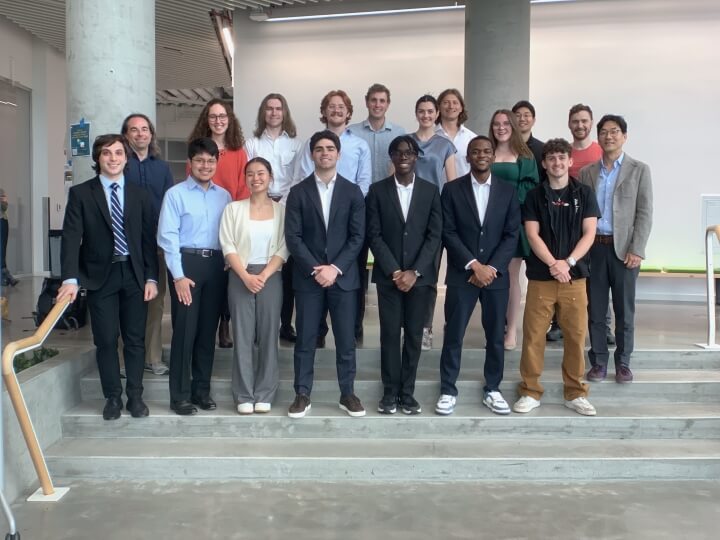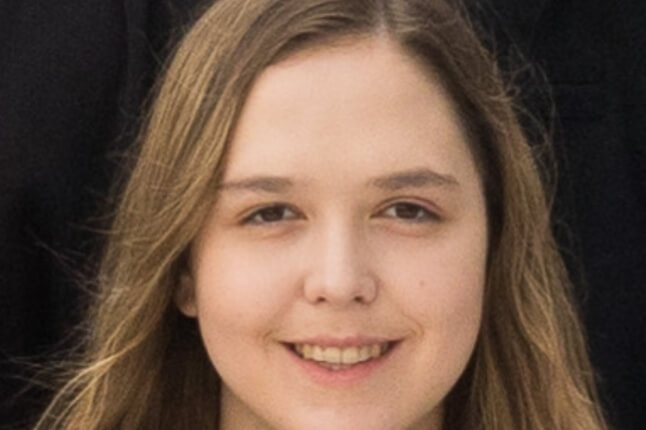News
Third-year students spent last semester exploring how to make future data centers more sustainable (Matt Goisman/SEAS)
When you think of the science behind data centers, you probably first think of computer science. It makes sense – data centers are essentially large collections of computers that maintain the data and applications that make more advanced computing possible.
You might think less about engineering, which is just as critical. Data centers need space. They need electricity – a lot of it – and the energy infrastructure to connect to that electricity. They also often need water, a common method of keeping the computers cool, which in turn, produces waste water. All of this results in data centers contributing a significant percentage of global carbon emissions.
As more and more advanced computing technologies gain widespread use, such as machine learning and large language models like ChatGPT, all those demands are going to increase in the coming years.
“With these tasks that need more and more and more computing power, we really need to be building more and more data centers to have these applications that we increasingly rely on,” said Aeden Marcus, an environmental science and engineering concentrator.
Marcus was part of a group of students at the Harvard John A. Paulson School of Engineering and Applied Sciences (SEAS) who spent their spring semester devising ways to build more sustainable data centers. Their work was done in “ES96: Engineering Problem Solving and Design Project,” a core course for third-year SEAS students pursuing S.B. engineering degrees.
“As we were beginning to talk about a specific ES96 topic, what screamed to me about data centers is all the infrastructure that goes into it,” said Chris Lombardo, course co-instructor and Associate Director of Undergraduate Studies in Electrical Engineering. “There are huge energy and power needs. There are huge water needs. What you do with the waste water, how reusable it is. There’s an opportunity for students from a wide variety of disciplines to explore and sink their teeth into this topic.”
Students in the ES96 section devised four digital tools to help data center operators either locate suitable new locations or begin to transition existing ones to more sustainable technology. The students’ work fell into four general areas: alternative energy generation, cooling efficiency, waste heat recycling, and improved water management.
“Once the students started to dig in, they realized that engineering is engineering,” said co-instructor Gu-Yeon Wei, Robert and Suzanne Case Professor of Electrical Engineering and Computer Science. “There are questions we have to ask to try to figure out what issues exist, and then what opportunities there are for us as a class over a relatively short period of time to do something meaningful. The students did a great job of narrowing the challenge enough to create a real contribution.”
In the alternative energy generation subgroup, the team designed an interactive map that displays information such as power plant locations, electrical transmission lines, and the potential for renewable energy sources such as solar, wind, or small modular nuclear reactors. Using the map, operators would have a much easier time finding locations that produce enough electricity to power the data center but have the potential to reduce their carbon footprint by using renewables for some of their electricity.
“I come from an energy background and being able to take data centers and interface it with that background, was really eye-opening,” said Jack Shea, a mechanical engineering concentrator who led the alternative energy subgroup. “We wanted to create a tool with our technical knowledge that could not only be used by engineers, but by a layman wanting to use it to figure out these technically complex problems.”
Data centers typically devote almost 40 percent of their electricity use to cooling systems. Systems that circulate cold air throughout the computer racks often waste electricity by blowing on computer components that don’t generate heat, while liquid immersion cooling systems require extra floor space to create a suitably large pool of cooling fluid for each computer, plus a pump to continually cycle out the warm fluid. Direct-to-chip cooling, in which coolant is used to chill metal plates placed next to specific components that generate a lot of heat, has the potential to reduce power consumption, but is a much newer technology. The ES96 cooling efficiency subgroup designed a flow chart to help data center operators who want to transition to direct-to-chip.
“We’re looking to see if we can help data centers implement cooling methods that optimize their energy consumption so that they can ensure environmentally and practically sustainable operations that meet their specific business needs,” said subgroup lead Honor Pimentel, a bioengineering concentrator.
Once that heat is removed from the computing racks, it has to go somewhere, and data center operators have already begun to experiment with how to repurpose that heat. A district in Dublin, for example, is currently implementing a plan to use waste heat from an Amazon data center to provide space heating and hot water for public buildings and housing. To encourage other data centers to consider similar plans, the ES96 waste heat recycling subgroup devised an online tool that helps operators determine how much heat energy at a data center could be repurposed, the associated carbon emissions reduction, and the kinds of devices and technologies that repurposed energy could power.
“I’m studying environmental science and engineering, and it’s really interesting for me to think more about how we can reuse things,” said subgroup lead Zora Zheng. “It’s really interesting how data centers aren’t just an electrical or mechanical engineering challenge. Everyone is able to bring together their different skill sets, backgrounds and experiences to see how we can work on the problem together.”
The fourth ES96 subgroup designed a map to provide information on available water supplies in regions being considered for new data centers. Data centers can consume 1-5 million liters of water per day, and that can be especially taxing on regions experiencing drought, such as states in the American Southwest. Using the group’s Environmental Justice StoryMap, both operators and policymakers can be better informed as to whether a data center is right for a specific community.
“Coming into this class, a lot of us didn’t know about the challenge of data centers,” said Marcus, who led the subgroup. “There’s so much information, and we wanted to be able to communicate that information moving forward. We’re not giving some tangible or physical thing to a company, but we wanted to make something that would continue to have an impact after we were done with the class.”
Topics: Academics, Climate, Computer Science, Electrical Engineering, Environmental Science & Engineering, Materials Science & Mechanical Engineering
Cutting-edge science delivered direct to your inbox.
Join the Harvard SEAS mailing list.
Press Contact
Matt Goisman | mgoisman@g.harvard.edu



